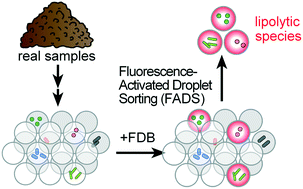Our official English website, www.x-mol.net, welcomes your feedback! (Note: you will need to create a separate account there.)
Fluorescence-activated droplet sorting of lipolytic microorganisms using a compact optical system†
Lab on a Chip ( IF 6.1 ) Pub Date : 2017-11-29 00:00:00 , DOI: 10.1039/c7lc00993c Yuxin Qiao 1, 2, 3, 4, 5 , Xiaoyan Zhao 1, 2, 3, 4, 5 , Jun Zhu 1, 2, 3, 4, 5 , Ran Tu 5, 6, 7, 8, 9 , Libing Dong 1, 2, 3, 4, 5 , Li Wang 1, 2, 3, 4, 5 , Zhiyang Dong 1, 2, 3, 4, 5 , Qinhong Wang 5, 6, 7, 8, 9 , Wenbin Du 1, 2, 3, 4, 5
Lab on a Chip ( IF 6.1 ) Pub Date : 2017-11-29 00:00:00 , DOI: 10.1039/c7lc00993c Yuxin Qiao 1, 2, 3, 4, 5 , Xiaoyan Zhao 1, 2, 3, 4, 5 , Jun Zhu 1, 2, 3, 4, 5 , Ran Tu 5, 6, 7, 8, 9 , Libing Dong 1, 2, 3, 4, 5 , Li Wang 1, 2, 3, 4, 5 , Zhiyang Dong 1, 2, 3, 4, 5 , Qinhong Wang 5, 6, 7, 8, 9 , Wenbin Du 1, 2, 3, 4, 5
Affiliation

|
Lipases are ubiquitous enzymes of great physiological significance that have been used extensively in multiple industries. Environmental microorganisms are a major source for the discovery of novel lipases with high catalytic efficiency and selectivity. However, current plate-based screening of lipase-producing strains is time consuming, labour intensive and inefficient. In this study, we developed an ultra-high throughput screening pipeline for lipase-producing strains based on fluorescence-activated droplet sorting (FADS) using a compact optical system that could be easily set up in an alignment-free manner. The pipeline includes droplet generation, droplet incubation, picoinjection of the fluorescence probe, and sorting of droplets with a throughput of 2 × 106 drops per h. We applied the pipeline to screen samples collected from different locations, including sediments from a hot spring in Tibet, soils from the Zoige wetland, contaminated soils from an abandoned oilfield, and a Chinese Daqu starter. In total, we obtained 47 lipase-producing bacterial strains belonging to seven genera, including Staphylococcus, Bacillus, Enterobacter, Serratia, Prolinoborus, Acinetobacter, and Leclercia. We believe that this FADS-based pipeline could be extended to screen various enzymes from the environment, and may find wide applications in breeding of industrial microorganisms.
更新日期:2017-11-29



























 京公网安备 11010802027423号
京公网安备 11010802027423号